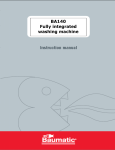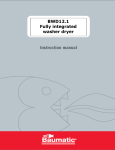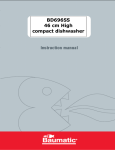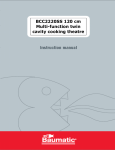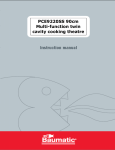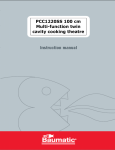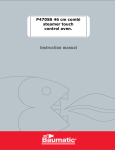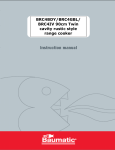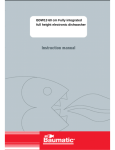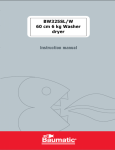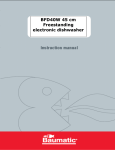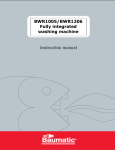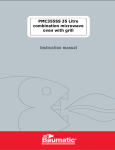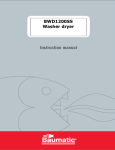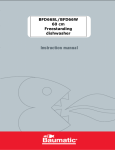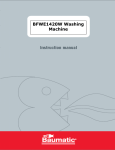Download Baumatic BA320W washing machine
Transcript
BA320W 7kg Freestanding washing machine USER MANUAL FOR YOUR BAUMATIC BA320W 7 kg Freestanding washing machine NOTE: This User Instruction Manual contains important information, including safety & installation points, which will enable you to get the most out of your appliance. Please keep it in a safe place so that it is easily available for future reference; for you or any person not familiar with the operation of the appliance. DD 01/07/09 2 Contents Environmental note 4 Important safety information 5–6 Specifications 7 Description of the appliance Control panel LCD display Detergent drawer 8 - 12 9 - 10 11 12 Preparing the wash cycle Preparing your garments for washing A selection of wash care symbols Detergents and conditioners 13 - 15 13 14 15 Wash program table Wash program guidance 16 - 17 17 Selecting a wash program Descriptions of the wash programs End of cycle Pausing a wash program Changing a wash program Delay start feature Spin reduction button Rinse hold Child lock 18 - 27 18 – 24 24 24 - 25 25 25 26 26 27 Maintenance and cleaning In daily use Control panel and washing machine cabinet Detergent drawer The washing machine drum Door Cleaning the drain pump filter Cleaning the water inlet filter Winter storage Removing stains Stain removal rules Stain removal guide Poor wash results 27 - 33 27 27 - 28 28 28 28 29 30 30 31 31 32 33 Installation Removing the transit bolts Locating your washing machine Connecting to the mains water supply Connecting to the water outlet Levelling the appliance Power supply Before first use maintenance wash 34 - 40 34 35 36 37 38 39 39 - 40 Error code failure system General troubleshooting 40 – 41 41 – 42 Contact details 44 3 Environmental note Note: Before discarding an old appliance, switch off and disconnect it from the power supply. Cut off and render any plug useless. Cut the cable off directly behind the appliance to prevent misuse. This should be undertaken by a competent person. Disable the door lock to make sure that children cannot get stuck inside the appliance. 4 Important safety information Your safety is of the utmost importance to Baumatic. Please make sure that you read this instruction booklet before attempting to install or use the appliance. If you are unsure of any of the information contained in this booklet, please contact the Baumatic Advice Line. General Safety o Repairs to your appliance must only be carried out by a Baumatic engineer or one of its authorised service agents. Any attempt by an inexperienced person to repair the appliance, could result in injury or damage to your washing machine. o If you notice that the mains cable is damaged. The appliance must not be used. The same applies if you notice that the worktop, control panel or base area is damaged. As this could allow access to the internal components of the machine. o The appliance should be switched off and isolated from the mains supply, before either cleaning or maintenance work is attempted. o The mains cable must not be used to pull the plug out of the electrical socket. o The machine should not be sprayed with water. o The glass of the porthole door may become hot during the higher temperature wash programs. o The machine should be allowed to cool before carrying out an emergency drain or cleaning the drain filter. o It is possible for small animals to chew either mains cables or water hoses, which could cause an electric shock hazard. Installation o The installation instructions contained within this user manual should be followed. o It is obligatory for the completed installation to comply with all relevant building regulations and local water authority requirements. 5 o Before the first use of the appliance, we advise that a 95°C cotton wash is completed. No garments should be placed inside the machine; however a small amount of detergent must be used. During Use o This appliance is only designed to wash normal domestic washloads. If you use your washing machine in any other way or it is incorrectly used, then Baumatic accepts no liability for any damage that might be caused and any guarantee will be void. o No attempt should be made to alter or modify the specifications of this appliance. o The detergents that you place in this appliance should be suitable for automatic washing machines. With regards to dosage levels, the detergent manufacturer’s recommendations should be followed. o You should not wash garments that have been in contact with flammable materials. o Your washing machine should not be used for dry cleaning. o If you use either dyes or bleaching agents inside this machine, then you should consult with the manufacturer of these products to make sure they are suitable for use in your washing machine. Baumatic cannot be held responsible for any damage that may result. o It is recommended that the appliance is unplugged and the water supply is switched off after the machine is used. Child Safety o Your washing machine should only be used by adults. You should not allow children in the area of the machine unsupervised. You should not let them touch the controls or play with the appliance. o It could be possible for a child or pet to gain access to the washing machine through the porthole door. Therefore please check the drum before using the appliance. o Any packaging that is removed from the machine should be kept away from children. o All detergents should be kept out of children’s reach in a safe place. 6 Specifications o 9 wash programs o 7 kg wash load o 1200 rpm maximum spin speed o 7 option buttons: Temperature (Temp) Spin Time Save Time Delay Option Start/Pause o o o o o o o o LED display Delay start Fuzzy logic Smooth spin speed and temperature regulation Unbalance control system 30 cm porthole and 180° opening Child lock Safety door lock Appliance dimensions Height: Width : Depth: 850 mm 600 mm 540 mm Ratings Energy efficiency class Wash performance class Water extraction performance class A+ A B For future reference please record the following information which can be found on the rating plate and the date of purchase which can be found on your sales invoice. The rating plate for your washing machine will either be located on the right hand side of the cabinet or behind the porthole door. Model Number ………………………………. Serial Number ………………………………. Date of Purchase ………………………………. 7 Description of the appliance Accessories 8 Control panel Power button Press this button to switch the machine on and off. Wash program selection knob Turn this control knob to select the wash program of your choice. To activate it you should press the power button to switch the appliance on and then turn the selection knob until it reaches the wash program that you want. Start/Pause button Press this button to start the wash program that you have selected or to pause a wash cycle when it is in progress. 9 Option button Press this button to select 3 wash cycle options:Crease care- This will help to prevent garments from creasing when the wash cycle has completed. Rinse+- This will add an extra rinse and increase the rinse time during a wash cycle. Pre-wash- This will add a wash and spin before the main wash cycle commences. Time delay button Press this button to delay the start of a wash cycle until a later time, up to a maximum of 12 hours. Time save button Press this button to decrease the time that a wash cycle takes to complete by 10 minutes. Spin button The washing machine will automatically select a spin speed for each wash program. However it is possible to alter the spin speed that it automatically selects, by pressing the Spin button. Temp button The washing machine will automatically select a temperature for each wash program. However it is possible to alter the wash temperature that it automatically selects, by pressing the Temp button. These buttons need to be pressed after a wash program has been selected, but before the wash program has been started. If you select a different wash cycle after pressing a program option, it will need to be reselected. 10 LCD display Wash cycle progress indicator This lights when a wash cycle is in progress, to indicate what stage of the wash cycle the appliance has reached. Wash program temperatures This light indicates which wash temperature has been selected. Spin speeds This light indicates which spin speed has been selected. Time save This light indicates that the Time Save feature has been switched on. Child lock The light indicates that the Child Lock has been switched on. Door lock This light indicates that the Door Lock is engaged. Timer display This indicates how long is left of the wash cycle that is in progress. Option indicators This indicates which options have been selected for a particular wash cycle. 11 Detergent drawer Main wash section This compartment should have detergent placed in it (you should also put a water softening agent in this section, if you use one). The detergent will be added to the drum at the start of the main wash program. Conditioner section This compartment should be used for liquid conditioners (fabric softener, starch). They will be added to the wash load during the final rinse. Pre wash section This compartment should have detergent placed in it, if you are going to select a pre-wash before the main wash cycle. 12 Preparing the wash cycle Preparing your garments for washing o Your washing should be sorted out, according to the fabric type and the wash care symbol that is printed on the garment’s wash care label. (see separate section on wash care symbols). o Your washing should also be sorted out according to the degree of soiling. o Check all pockets on a garment to make sure that they are empty. o Remove any detachable metal items (badges, paperclips, safety pins etc). o Zips should be closed, duvet covers and pillow cases should be buttoned up and any loose straps should be tied up. This will help to prevent other garments from getting damaged during the wash. o Woollens and knitted coloured fabrics should be turned inside out before being washed in the appliance. o Small delicate items (tights, baby socks) should be placed in either a washing net or a zipped pillow case. o Curtains should be handled with particular care. All plastic hooks or metal strips must be removed before being washed in the appliance. o Coloured items and whites should be washed in separate wash cycles. o New garments often contain an excess of dye, therefore it is advisable to wash them separately for their first wash. o Garments should be unfolded and shook out before being placed inside the machine. 13 A selection of wash care symbols o The wash care symbols should be used to help you to select the most suitable wash program. They will also help you to sort your laundry into different loads, depending on the fabric type and the highest temperature which the garment can be washed at. 14 Detergents and conditioners The amount of detergent that you need to use in your appliance, will depend on o The degree of soiling. Lightly soiled garments in general require less detergent. o The size of the wash load. A smaller wash load will require a reduction in the amount of detergent. o The hardness of your tap water. The harder your water is, then the more detergent you will need to use. The detergent manufacturers normally give guidance as to how much extra detergent should be used, depending on the hardness of the water. Liquid detergent If you are using liquid detergent, then in the majority of cases the liquid should be placed inside the dosing device supplied by the detergent manufacturer and placed inside the drum. All instructions on the detergent packaging should be followed. Water softening agents If your tap water is hard, then it may be prudent to utilise a water softening agent. This will help to ensure that the appliance does not become clogged with hard water deposits. You may also find that it will allow you to lessen the amount of detergent that you are using. When using any detergent or water softening agent, the recommendations of the manufacturers should be followed. 15 Wash program table Program Fabric type Cotton White cotton, linen, towel and sheets Colour-fast garments (shirts, night dresses, pyjamas) and lightly soiled white cottons (underwear) As cotton Eco Synthetic Polyamide, acrylic, polyester Delicate Wool Hand Wash Quick Delicate laundry, easily damaged (silk, curtains) Machine washable woollens with pure new wool only “Hand wash” marked delicates and woollens Coloured laundry which is lightly soiled Possible Options temperatures 60°C* Prewash, Rinse+, (95°C, Crease 40°C, Care 30°C) 60°C* 40°C* (60°C, 30°C) Cold* Cold* Cold* (30°C) 30°C* (Cold, 40°C) * This indicates the default wash automatically selected by the appliance. Prewash, Rinse+, Crease Care Prewash, Rinse+, Crease Care Rinse+, Crease Care Rinse+, Crease Care Rinse+, Crease Care Rinse+, Crease Care temperature Maximum load 7 kg 7 kg Less than 1.5 kg Less than 1 kg Less than 1 kg Less than 1 kg Less than 1 kg that will be Pre Wash: If the laundry is heavily soiled, the “Pre Wash” option is recommended. This option is available for Cotton and Synthetic wash programs. You should place detergent in the pre-wash compartment of the detergent drawer, as well as in the main wash compartment. Rinse+: Will introduce an additional rinse, which will help to remove traces of detergent residue. 16 Crease care: Will introduce clockwise rotations at the end of the wash cycle, which will help to reduce the amount of creasing that you get in garments. Eco: By selecting the Eco wash program, the water temperature is lowered and the washing time is increased. This allows you to reduce energy consumption. Wash program guidance o A wash program option can only be selected if the program table advises that it is possible with the wash cycle you have selected. o The washing machine automatically selects a temperature for a particular wash program. However it is possible to alter the temperature by using the TEMP button. The available temperatures are shown in the wash program table on the previous page. o The washing machine automatically selects a spin speed for a particular wash program. However it is possible to alter the spin speed by using the SPIN button. Certain spin speeds will not be available on particular wash cycles. o Important: You should make sure that the selected spin speed is appropriate for the garments that you are washing. o If you select “rinse hold”, then the machine will leave the garments suspended in water after the rinses and not go into a spin cycle. o Important: Before opening the door of the appliance, you MUST spin the clothes and drain the water. See the section called “Spin only” on page 23 - 24. o The active phases will appear at the top of the LED display, as the wash program progresses. o The LED display shows an approximate time for the selected wash cycle. Please note that factors external to the machine, e.g. the temperature of your water supply, your water pressure etc. can affect the time it takes for a wash cycle to complete. 17 Selecting a wash program Cotton program o Put the laundry into the drum and then close the door. o In the detergent drawer, put detergent into the main wash and pre-wash compartments. o Put detergent into the pre wash compartment only if you want to use the pre-wash option. o Softener should be poured into the middle compartment of the detergent drawer; the level should be below the ‘MAX’ level. o If you want to use bleach, then you should put it into the main wash compartment with your detergent. o Press the power button, the LCD display will show “---“ and all the program lights will come on. o Use the wash program selection knob to select the Cotton program. o A wash temperature of 40°C, with an 800 rpm spin and 3 rinses will be selected automatically by the appliance. o You can use the TEMP button to adjust the wash temperature, 30°C, 40°C, 60°C and 95°C wash temperatures are available. o You can use the SPIN button to adjust the spin speed. o You can use the OPTION button to select Pre-wash, Rinse+ and Crease Care wash cycle options. Continue to press the OPTION button until the wash cycle option or combination of options that you require are lit on the LCD display. o Press the Start/Pause button, the door will lock (confirmed by the indicator on the LCD display) and after a few seconds you will hear the machine start to fill with water. 18 Eco program o Put the laundry into the drum and then close the door. o In the detergent drawer, put detergent into the main wash compartment. o Softener should be poured into the middle compartment of the detergent drawer; the level should be below the ‘MAX’ level. o If you want to use bleach, then you should put it into the main wash compartment with your detergent. o Press the power button, the LCD display will show “---“ and all the program lights will come on. o Use the wash program selection knob to select the Eco program. o A wash temperature of 60°C, with an 800 rpm spin and 3 rinses will be selected automatically by the appliance. The wash temperature of 60°C is not adjustable for the ECO wash program o You can use the SPIN button to adjust the spin speed. o You can use the OPTION button to select Rinse+ and Crease Care wash cycle options. Continue to press the OPTION button until the wash cycle option or combination of options that you require are lit on the LCD display. o Press the Start/Pause button, the door will lock (confirmed by the indicator on the LCD display) and after a few seconds you will hear the machine start to fill with water. Synthetic program o Put the laundry into the drum and then close the door. The maximum wash load size is 1.5 kg for the synthetic program. o In the detergent drawer, put detergent into the main wash and pre-wash compartments. o Put detergent into the pre wash compartment only if you want to use the pre-wash option. o Softener should be poured into the middle compartment of the detergent drawer; the level should be below the ‘MAX’ level. 19 o If you want to use bleach, then you should put it into the main wash compartment with your detergent. o Press the power button, the LCD display will show “---“ and all the program lights will come on. o Use the wash program selection knob to select the Synthetic program. o A wash temperature of 40°C, with an 800 rpm spin and 3 rinses will be selected automatically by the appliance. o You can use the TEMP button to adjust the wash temperature; 30°C, 40°C and 60°C wash temperatures are available. o You can use the SPIN button to adjust the spin speed. o You can use the OPTION button to select Pre-wash, Rinse+ and Crease Care wash cycle options. Continue to press the OPTION button until the wash cycle option or combination of options that you want are lit on the LCD display. o Press the Start/Pause button, the door will lock (confirmed by the indicator on the LCD display) and after a few seconds you will hear the machine start to fill with water. Delicate program o Put the laundry into the drum and then close the door. The maximum wash load size is 1 kg for the Delicate program. o In the detergent drawer, put detergent into the main wash compartment. o Softener should be poured into the middle compartment of the detergent drawer; the level should be below the ‘MAX’ level. o If you want to use bleach, then you should put it into the main wash compartment with your detergent. o Press the power button, the LCD display will show “---“ and all the program lights will come on. o Use the wash program selection knob to select the Delicate program. 20 o A wash temperature of COLD, with a 400 rpm spin and 2 rinses will be selected automatically by the appliance. The wash temperature of COLD is not adjustable for the Delicate wash program o You can use the SPIN button to adjust the spin speed. A 1000 rpm spin speed is not available with the Delicate wash program. o You can use the OPTION button to select Rinse+ and Crease Care wash cycle options. Continue to press the OPTION button until the wash cycle option or combination of options that you want are lit on the LCD display. o Press the Start/Pause button, the door will lock (confirmed by the indicator on the LCD display) and after a few seconds you will hear the machine start to fill with water. Wool program o Put the laundry into the drum and then close the door. The maximum wash load size is 1 kg for the Wool program. o In the detergent drawer, put detergent into the main wash compartment. You should make sure not to use more than the detergent manufacturer’s recommended amount of detergent for woollens, otherwise this may lead to excessive sudsing. o Softener should be poured into the middle compartment of the detergent drawer; the level should be below the ‘MAX’ level. o If you want to use bleach, then you should put it into the main wash compartment with your detergent. o Press the power button, the LCD display will show “---“ and all the program lights will come on. o Use the wash program selection knob to select the Wool program. o A wash temperature of COLD, with a 400 rpm spin and 2 rinses will be selected automatically by the appliance. The wash temperature of COLD is not adjustable for the Wool wash program o You can use the SPIN button to adjust the spin speed. A 1000 rpm spin speed is not available with the Wool wash program. 21 o You can use the OPTION button to select Rinse+ and Crease Care wash cycle options. Continue to press the OPTION button until the wash cycle option or combination of options that you want are lit on the LCD display. o Press the Start/Pause button, the door will lock (confirmed by the indicator on the LCD display) and after a few seconds you will hear the machine start to fill with water. Hand wash program o Put the laundry into the drum and then close the door. The maximum wash load size is 1 kg for the Hand wash program. You should only use the Hand wash program for garments that have hand wash marked on their wash care label. o In the detergent drawer, put detergent into the main wash compartment. o Softener should be poured into the middle compartment of the detergent drawer; the level should be below the ‘MAX’ level. o If you want to use bleach, then you should put it into the main wash compartment with your detergent. o Press the power button, the LCD display will show “---“ and all the program lights will come on. o Use the wash program selection knob to select the Hand wash program. o A wash temperature of COLD, with a 400 rpm spin and 3 rinses will be selected automatically by the appliance. o You can use the TEMP button to adjust the wash temperature; COLD and 30°C wash temperatures are available. o You can use the SPIN button to adjust the spin speed. A 1000 rpm spin speed is not available with the Hand wash program. o You can use the OPTION button to select Rinse+ and Crease Care wash cycle options. Continue to press the OPTION button until the wash cycle option or combination of options that you want are lit on the LCD display. o Press the Start/Pause button, the door will lock (confirmed by the indicator on the LCD display) and after a few seconds you will hear the machine start to fill with water. 22 Quick 30 program o Put the laundry into the drum and then close the door. The maximum wash load size is 1 kg for the Quick 30 wash program. o In the detergent drawer, put detergent into the main wash compartment. o Softener should be poured into the middle compartment of the detergent drawer; the level should be below the ‘MAX’ level. o If you want to use bleach, then you should put it into the main wash compartment with your detergent. o Press the power button, the LCD display will show “---“ and all the program lights will come on. o Use the wash program selection knob to select the Quick 30 program. o A wash temperature of 30°C, with an 800 rpm spin and 2 rinses will be selected automatically by the appliance. o You can use the TEMP button to adjust the wash temperature; COLD, 30°C and 40°C wash temperatures are available. o You can use the OPTION button to select Rinse+ and Crease Care wash cycle options. Continue to press the OPTION button until the wash cycle option or combination of options that you want are lit on the LCD display. o Press the Start/Pause button, the door will lock (confirmed by the indicator on the LCD display) and after a few seconds you will hear the machine start to fill with water. Drain program o Put the laundry into the drum and then close the door. o Press the power button, the LCD display will show “---“ and all the program lights will come on. o Use the wash program selection knob to select the Drain program. o Press the Start/Pause button, the door will lock (confirmed by the indicator on the LCD display) and after a few seconds you will hear the machine start to drain. 23 o IMPORTANT: Please note that the appliance will not spin on this particular wash cycle. Rinse + spin program o Put the laundry into the drum and then close the door. o Press the power button, the LCD display will show “---“ and all the program lights will come on. o Use the wash program selection knob to select the Rinse + Spin program. o Use the SPIN button to adjust the spin speed. o Press the Start/Pause button, the door will lock (confirmed by the indicator on the LCD display) and after a few seconds you will hear the machine start fill with water. o IMPORTANT: Your appliance has an unbalance control system. If this system detects that the washload is unevenly distributed inside the drum. Your washing machine will try to redistribute the load before spinning. If after several attempts it is unable to redistribute the washload, then the appliance will either spin at a slower speed or skip the spin cycle and proceed to the drain section of the wash cycle. o Uneven load distribution can be caused by too large a wash load or too small a wash load. It can also occur if a single item is washed inside the appliance. End of cycle o At the end of a wash cycle, the DOOR LOCK light will remain lit for a couple of minutes. o IMPORTANT: You should not attempt to open the porthole door until the DOOR LOCK light has gone out. o When the DOOR LOCK light has gone out and you hear the door lock disengage, you can open the porthole door and remove the laundry. Pausing a wash program o If you want to pause a wash program temporarily, you should press the START/PAUSE button. 24 o When you want to restart START/PAUSE button again. the wash cycle, press the Changing a wash program o If you want to change a wash program once the wash cycle is already in progress, you should first press the START/PAUSE button. o Use the wash program selection knob to change the wash program to the one that you require. o IMPORTANT: Changing the wash program will cancel any spin or temperature alterations that you have made and any program options that you have selected. You will need to make the spin/ temperature alterations again and re-select any program options that you require. Delay start feature Your appliance has a delay start feature, which allows you to delay the start of a wash cycle until a later time. o Select a wash program and any program options that you require in the normal manner. o Press the TIME DELAY button and 2.00 will appear on the timer display. Each subsequent press of the TIME DELAY button will increase the time on the timer display by 1 hour. o You can delay the start of the wash cycle by a maximum of 12 hours and a minimum of 2 hours. o When you have selected the time delay period that you require, press the START/PAUSE button. The wash cycle will not commence, but the door lock light will come on. The wash cycle will start automatically when the time delay period has elapsed. o To cancel the delay start, press the POWER button to switch the machine off. 25 Spin reduction button Your appliance will automatically select a spin speed depending on the wash program that you have chosen. It is possible to alter the spin speed using the SPIN button. o Once a wash program has been selected, press the SPIN button to see what spin speeds are available for a particular wash program. o When you have reached the spin speed that you require, press the START/PAUSE button to commence the wash cycle. Rinse hold You can set your appliance so that it will not spin at the end of the wash cycle and will suspend the wash load in water. This is useful if you will not be present at the end of a wash cycle to remove laundry from the drum immediately. o Once a wash program has been selected, press the SPIN button to see what spin speeds are available for a particular wash program. If RINSE HOLD lights, then it is available for a particular wash program. o When the wash cycle has completed, it will not enter the spin cycle. IMPORTANT: You must make sure that you set the machine to spin before switching the appliance off and/or attempting to open the door. o If you press the SPIN button, you can select the spin speed of your choice. Alternatively you can turn the wash program selection knob to the Drain program and then press the START/PAUSE button. The appliance will drain the water without spinning the clothes. 26 Child lock Your appliance has a child lock, if this is set it will mean that nobody can affect the operation of the wash program once it has started. o Select a wash program and any program options that you require in the normal manner. o Press the START/PAUSE button to start the wash cycle. o Simultaneously hold down the TIME SAVE and TIME DELAY buttons for a few seconds, the child lock light will come on. o When the Child Lock light is switched on, the only button/dial that will operate is the POWER button. If you turn the washing machine off using the POWER button, the child lock option will be cancelled. o To change the wash cycle when the child lock is engaged, press the TIME SAVE and TIME DELAY buttons simultaneously, then press the START/PAUSE button. o Use the wash program selection knob to select the program that you want to use and then press the START/PAUSE button again to start the wash cycle. Maintenance and cleaning In daily use o Once a wash cycle has completed, you should pull out the detergent drawer slightly, so it can dry out. o Leave the porthole door ajar for a short while after a wash cycle has completed. This should help to prevent stagnant smells and to protect the door seal. o Close the water tap. o We suggest that you disconnect the appliance from your mains supply, when it is not in use. Control panel and washing machine cabinet. IMPORTANT: Do not use any abrasive cleaner or household polish on either the control panel or operating parts. o Wipe over the control panel and the external surface of the machine using a brand new damp cloth with warm water. 27 o If you ever spill any liquid detergent or conditioner from the detergent drawer onto the washing machine cabinet, then these should be cleaned up immediately as they could be corrosive. Detergent drawer Occasionally the detergent drawer should be cleaned, to remove any detergent residue that has built up. o Pull the detergent drawer out as far as it will go, press down the catch in the middle section of the drawer and then pull the drawer out. o Wash the detergent drawer in warm, soapy water. For ease of cleaning, you can remove the upper part of the fabric softener compartment. o Detergent can also accumulate inside the detergent drawer recess, so you should also clean this out using a brush o Once you have finished cleaning the detergent drawer and recess, you should slide the drawer back into its original position. The washing machine drum The drum of your washing machine is constructed from stainless steel. However if there are objects that can rust placed inside the drum, then it is possible for the drum to become stained. IMPORTANT: Do not use a descaling agent, iron/steel wool or scouring agents to clean the drum of your appliance. o Remove any rust stains on the drum with an appropriate stainless steel cleaning agent. Door o You should regularly check to see if any deposits have formed, or there are any foreign bodies inside or underneath the rubber door gasket. This sits inside the opening of the porthole door. 28 Cleaning the drain pump filter IMPORTANT: Switch off your washing machine and disconnect the plug from your mains supply. You should clean out the filter approximately every ten washes. If the drain pump filter is not cleaned regularly, then your appliance may find it difficult to pump out water efficiently. o You should regularly check to see if any deposits have formed, or there are any foreign bodies in the drain pump filter. o Locate the drain pump filter flap that is on the base of the appliance in the front right hand corner. o Use a coin to open the drain pump filter flap. o Pull out the bail tube that is to the left of the drain pump filter. Place the end of the tube into an adequately sized bowl and then remove the cap from the end of it. o When water no longer runs out of the bail tube, you can turn the drain pump filter cover anti-clockwise. This will allow you to remove the drain pump filter from its housing. o Remove any debris from the drain pump filter by running it under a tap. o After cleaning, reinsert the drain pump filter into its housing. Tighten the drain pump filter by turning it clockwise, you should keep tightening it until you cannot turn it any further. o Reinsert the cap into the end of the bail hose, making sure that it is securely in place. Slide the bail hose back into its original position and then close the drain pump filter flap. IMPORTANT: If you are draining water from the bail hose and drain pump filter in an emergency. You should take care as the water coming from the machine mid-cycle could be hot. Especially if the water is being drained in the middle of one of the hotter wash cycles. 29 Cleaning the water inlet filter IMPORTANT: Switch off your washing machine and disconnect the plug from your mains supply. o Switch off the water supply to the washing machine and then separate the inlet hose from the water tap. o Pull out the inlet filter. o Use a small brush to remove any dirt or obstructions from the inlet filter. o Put the inlet filter back in its original position and reconnect the inlet hose to the water tap. Finally switch back on the water supply to the machine. Winter storage o You should install your appliance in a location where it will not be subjected to freezing temperatures. o If you are going to store your appliance in a location where the temperature will drop below freezing in winter, then you should follow the table below. Preparing for Winter o o o o Disconnect from mains water supply. Disconnect and drain the water from the inlet hose. Run the washing machine on a drain or spin setting for 1 minute. Unplug the power supply cord. Using after Winter o o o o o Flush water pipes and hoses. Reconnect water inlet hose. Reconnect to water supply. Reconnect power supply cord. Reconnect water outlet hose. 30 Removing stains Garments that are covered in stains, grease or are heavily soiled may need to be pre-washed or soaked before being placed inside of the washing machine. o Soaking helps to remove protein-type stains, like blood, milk or grass. o Pre-washing helps to loosen soil before the main wash. Stain removal rules o Use warm water for soaking or pre-washing stained laundry. Hot water can set stains. o Most stains are easier to remove when they are fresh. o Before treating any stain try to establish; what kind of stain it is, how old the stain is, what the fabric type is and whether the fabric is colourfast (check the care label to find this out). o Washing and drying can fix some stains. o When bleach is recommended, use a mild fabric bleach that is safe for the fabric. o If you need to use a stain remover, put the stained area face down on a paper towel or white cloth. Apply the stain remover to the back of the stain. This forces the stain off the fabric, instead of through it. 31 Stain removal guide STAIN Blood Chewing gum Chocolate/ Cocoa Coffee Cream/Milk Ice cream Deodorant Egg Fabric softener Fruit stains Grass Grease and oil Iron or rust Lipstick Mildew Mud Oil based paint Water based paint Scorch marks TO REMOVE Rinse immediately in COLD water. If the stain remains, soak in cold water with an enzyme prewash. Use ice in a plastic bag to harden the gum. Scrape off what you can and then sponge with white spirit. Sponge with COLD water and then soak in an enzyme prewash. If stains persist, rub in a little detergent and then rinse in cold water. Blot up quickly and then rinse out in COLD water. Rub in a little detergent and then machine wash at the maximum temperature allowed according to the wash care label. Rinse in COLD water and wash normally. If the stain is still apparent, sponge with white spirit. Rub the affected area with white vinegar and then rinse out in COLD water. Sponge with white spirit. Treat stiffened areas with an enzyme pre-wash. Soak in a COLD enzyme pre-wash, rinse and wash normally. Rub the affected area with a bar of soap and then wash normally. Treat as soon as possible by sponging with COLD water. Rub a little detergent on the stain and then wash normally. Sponge with white spirit. Rub in an enzyme pre-wash and then wash normally. Lay the affected area facedown on an absorbent cloth. Using white spirit or dry cleaning fluid, work on the back of the stain. Wash normally. Apply lemon juice and salt, and then place in the sun. Wash normally. Sponge with white methylated spirit and wash normally. Wash in WARM water and detergent. Moisten area with lemon juice, dry in the sun and wash normally. If the stain persists and the fabric is suitable, use a mild fabric bleach. Brush off any dry mud. Rinse in COLD water. If the stain persists, rub in a little detergent and wash normally. Scrape off any fresh paint and then sponge off with non flammable dry cleaning fluid and wash normally. Treat whilst still wet, rinse in WARM water and wash normally. Dampen a cloth with hydrogen peroxide, lay it over the affected area and press with a fairly hot iron. 32 Poor wash results My garments are looking grey and there are limescale deposits present in the drum of my washing machine. o o o o There is not enough detergent being added. The incorrect detergent is being used. Stains are not being pre-treated. The correct wash program or wash temperature was not selected. I have followed the advice given above, but my garments are still coming out with grey stains on them. o The garments are soiled with oils, ointments or grease and were washed without enough detergent. o The wash temperature selected was too low. o Fabric conditioner has come into contact with the garments. If this happens try to wash out these stains as quickly as you can and try to avoid getting conditioner on the garments in future. After the final rinse, I can still see foam. o Modern detergents can result in there still being foam in the final rinse, this does not mean that the washing is not being rinsed properly. There is white residue on my garments when I remove them from the appliance. o Modern detergents can contain insoluble contents; white residue after a wash cycle is not necessarily a sign of the garments being insufficiently rinsed by the washing machine. o You should shake out the garment or brush it off. In future possibly turn the garment inside out before it is washed. You may wish to move from a powder detergent and switch to a liquid detergent instead. 33 Installation IMPORTANT: THIS INSTALLATION MUST BE COMPLETED BY A SUITABLY QUALIFIED PERSON. BAUMATIC ONLY SANCTION THE INSTALLATION GIVEN IN THIS INSTRUCTION MANUAL. YOU SHOULD KEEP THE TRANSIT PACKAGING, IN CASE YOU NEED TO TRANSPORT THE MACHINE IN THE FUTURE. Removing the transit bolts IMPORTANT: Before installing or operating the washing machine, YOU MUST remove the transit bolts that hold the drum in position whilst the appliance is being transported. o On the rear of the appliance, identify the 3 transit bolts. o Unscrew the 3 transit bolts using a 10 mm hex wrench or spanner, or a cross-tip screwdriver. o You should keep the 3 transit bolts in case you need to transport the appliance elsewhere in future. o Cover the holes that you removed the transit bolts from, using the 3 transit covers supplied. 34 Locating your washing machine o Before commencing installation, check the location where you intend to install the appliance. You should make sure that you have everything in place that is necessary for the correct installation. o Do not place or store your washing machine in a location where the ambient temperature could fall below 0°C, otherwise the water in it could freeze up. o Never place or store laundry products on top of the appliance. o Install the washer on a flat, solid floor. If the washer is installed on an uneven or suspended floor, it could cause excessive noise and severe vibration, which may result in the malfunction of the appliance. o You should also level off the washing machine, using the adjustable feet on the base of the appliance. o There should be a gap of 2 cm either side of the washing machine; a 10 cm gap should be left behind the appliance. 35 Connecting to the mains water supply IMPORTANT: The washing machine should never be connected to the water mains using an existing inlet hose, YOU MUST utilise the inlet hose that is provided with the appliance. Your appliance should only be connected to a cold water supply. For an ordinary tap For a screw-shaped tap 36 Connecting to the water outlet 9 Secure the drain hose, so that it cannot move whilst the washing machine is in use. 9 Place the end of the drain hose on your drain pipe. Push it a short way down into your drain pipe. 9 IMPORTANT: Do not insert the drain hose too deeply into the water pipe, as this may cause siphoning. 9 Utilise the outlet hose retainer and tie strap to keep the outlet hose in position when the appliance is on a wash cycle. 9 NEVER EXTEND THE DRAINAGE HOSE FROM ITS ORIGINAL LENGTH. 37 Levelling the appliance 9 Place the washing machine on a solid and level floor surface. 9 DO NOT PLACE THE WASHING MACHINE ON A CARPET OR A SUSPENDED FLOOR. IMPORTANT: There should be no instability of the machine when the adjustable legs have been set to the correct level. 38 Power supply 9 IMPORTANT: The electrical socket must still be accessible once the appliance is installed. 9 Consult the rating plate, located on the inner rim of the porthole door or the right hand side of the cabinet BEFORE making the electrical connections. Ensure that the voltage reaching the plug, is the same as that on the rating plate. 9 DO NOT REMOVE THE RATING INFORMATION ON IT IS IMPORTANT. PLATE AS THE 9 The moulded plug that is supplied with the appliance must be placed into an earthed and insulated socket. 9 Broken or damaged power leads must only be replaced by a suitably qualified person. A power lead of a similar type must be used in replacement. 9 IMPORTANT: We do not recommend that this appliance is connected to an extension lead. Before first use maintenance wash o When your washing machine has been correctly installed, we recommend that you perform a maintenance wash cycle, without any clothing being placed inside of the drum. o This will check that all aspects of the installation are correct; it will also remove any deposits that may have been left on the drum by the manufacturing process. o Select a 95°C cotton wash. 39 o A small quantity of maintenance wash. detergent should be used during this Error code failure system If your appliance senses that it is not operating correctly, then an error code may appear on the LCD display. The following error codes can possibly be remedied by the customer and the steps outlined below should be followed. ANY MAINTAINEANCE ON BEFORE COMPLETING APPLIANCE, IT SHOULD BE DISCONNECTED FROM YOUR POWER SUPPLY. THE o If IE, LE, OE or UE are displayed on the LED display, you should switch the appliance off using the POWER button and then switch it back on again using the POWER button. o If PFE is displayed on the LED display, you should turn the appliance off using the POWER button, switch it back on again using the POWER button, press the SPIN button and then press the START/PAUSE button. 40 General troubleshooting Water under the washing machine o Tighten the drain pump filter. o Check the drain and inlet hose and make sure that they are fully tightened. Washing machine vibrates during the spin cycle o Check that the transport locking devices have been removed (see installation instructions). o Make sure that the washing machine is installed on a flat and level floor. o Ensure that all four feet are resting firmly on the floor, by pressing down on each corner and making sure that the appliance is stable. If it is unstable then follow the “Locating your washing machine” and “Levelling the appliance” sections. Poor spin results o Clean the drain pump (see “Cleaning the drain pump filter” section). Water in the detergent drawer o Although there will be some water residue left in the detergent drawer after a wash cycle has completed. If the drawer is full of water then you may need to clean the detergent drawer. 41 IF THE FAULT CODE REAPPEARS AFTER FOLLOWING THE ABOVE ADVICE AND CLEARING THE FAULT CODE. YOU SHOULD TURN OFF THE APPLIANCE; DISCONNECT THE APPLIANCE FROM YOUR MAINS SUPPLY. THEN ARRANGE FOR AN ENGINEER TO ATTEND THE APPLIANCE. YOU SHOULD CONTACT BAUMATIC CUSTOMER CARE ON TELEPHONE NUMBER (0118) 933 6911. Please note that if an engineer is asked to attend whilst the product is under guarantee and finds that the problem is not the result of an appliance fault, then you may be liable for the cost of the call out charge. The appliance must be accessible for the engineer to perform any necessary repair. If your appliance is installed in such a way that an engineer is concerned that damage will be caused to the appliance or your kitchen, then he will not complete a repair. This includes situations where appliances have been tiled in, sealed in with sealant, have wooden obstructions placed in front of the appliance, like plinths. Or any installation other than the one specified by Baumatic Ltd. has been completed. Please refer to the conditions of guarantee that appear on the warranty card that you receive with the appliance. IMPORTANT: Baumatic Ltd. operates a policy of continuous improvement and reserves the right to adjust and modify its products without prior notification. 42 United Kingdom Baumatic Ltd., Baumatic Buildings, 6 Bennet Road, Reading, Berkshire RG2 0QX United Kingdom Czech Republic Baumatic CR spol s.r.o. Amperova 495 46215, Librec Czech Republic Sales Telephone (0118) 933 6900 Sales Fax (0118) 931 0035 Service Telephone (0118) 933 6911 Service Fax (0118) 986 9124 Spares Telephone (01235) 437244 Advice Line Telephone (0118) 933 6933 www.baumatic.cz E-mail: [email protected] [email protected] [email protected] [email protected] Website: www.baumatic.co.uk Republic of Ireland 01- 6266 798 +420 800 185 263 Slovak Republic Baumatic Slovakia, s.r.o. Skultetyho 1 831 04 Bratislava 3 Slovakia +421 255 640 618 Germany Baumatic Gmbh Janderstrasse 9 Mannheim, 68199 Germany +4962 112 9190 www.baumatic.de Italy Baumatic Italia S.R.L. Via Caltana 129 Campodarsego (Padova), 35011 Italy +3904 9920 2297 www.baumatic.it Holland Baumatic Benelux B.V. Grindzuigerstraat 22 1333 MS ALMERE The Netherlands +3136 549 1555 www.baumatic.nl 43












































